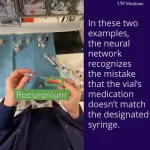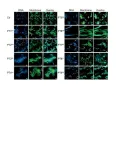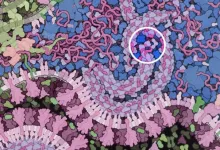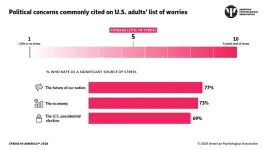(Press-News.org) For some proteins, a single mutation, or change in its DNA instructions, is all it takes to tip the balance between functioning normally and causing cancer. But despite causing major disease, these slightly mutated proteins can resemble their normal versions so closely that treatments designed to target mutants could also harm healthy cells.
Led by researchers at NYU Langone Health and its Perlmutter Cancer Center, a new study describes the development of a biologic, a drug derived from natural biological systems, that targets a mutant cancer protein called HER2 (human epidermal growth factor receptor 2) without attacking its nearly identical normal counterpart on healthy cells. While still in the early stages, this technique could lead to new therapies to treat cancer patients with HER2 mutations with minimal side effects, the researchers say.
“We set out to make an antibody that can recognize a single change in the 600 amino acid building blocks that make up the exposed part of the HER2 protein, which conventional wisdom says is very difficult, said lead study author Shohei Koide, PhD, a professor in the Department of Biochemistry and Molecular Pharmacology at NYU Grossman School of Medicine and member of Perlmutter Cancer Center. “The fact that we were able to detect the difference of a single amino acid so cleanly was a surprise.”
The new findings revolve around HER2, a protein that occurs on the surfaces of many cell types and that turns on signaling pathways that control cell growth. It can cause cancer when a single amino acid swap locks the protein into “always-active” mode, which in turn causes cells to divide and multiply uncontrollably.
Cancer can also result when cells accidentally make extra copies of the DNA instructions that code for the normal version of HER2 and express higher levels of the protein on their surfaces. There are a few FDA-approved therapies, including trastuzumab and pertuzumab, that can treat this kind of cancer, but these therapies all work at the level of HER2 on the cell surface, where only low levels of the mutated version of HER2 occur. “That means we cannot mark cancer cells just by looking at HER2 levels,” said Dr. Koide, who also serves as director of cancer biologics at NYU Langone. In addition, since some approved therapies cannot tell the difference between mutant and normal HER2, they are more likely to harm healthy cells expressing normal HER2.
Publishing in the journal Nature Chemical Biology online Oct. 22, the study shows how the researchers harnessed their new protein-engineering technique to develop antibodies that recognize only mutant HER2. Antibodies are large, Y-shaped proteins that bind to specific targets and flag down immune cells to destroy those targets.
In a process that mimics natural antibody development, the researchers subjected antibodies to multiple rounds of mutation and selection, looking for variants that recognized mutant HER2 but not the normal version. By taking atomic images with a cryo-electron microscope, the team saw how their new antibodies interacted with HER2 spatially (kept two HER2 molecules from interacting to signal), which let the team continually refine their antibody designs.
But selectively recognizing mutant HER2 was only part of developing an effective cancer treatment, since antibodies need to work with the immune system to kill cancer cells. A particular challenge is the case in which cancer cells have only small numbers of mutant HER2 on their surfaces to which an antibody can attach.
To address this challenge, the researchers converted their antibody into a bispecific T cell engager, a molecule in which the antibody targeting the mutant protein is fused to another antibody that binds to and activates immune cells called T cells. One end of the antibody sticks to the mutant HER2 on a cancer cell, while the other triggers T cells to kill the cancer cell. Further testing showed this method killed mutant HER2 cancer cells in dishes but spared normal ones.
When the researchers tested their T-cell engagers in mice with mutant HER2 tumors, the treatment significantly reduced tumor growth. It did so without causing weight loss or visible sickness in the mice, which suggested the treatment had few side effects in the animals. However, Dr. Koide noted that because there are differences between mouse and human proteins, it is possible the lack of obvious side effects stemmed from the antibody binding even less to mouse wild-type HER2 than to the human version. Future studies will tell.
Moving forward, Dr. Koide said the researchers will continue fine-tuning their antibody with the goal of developing a treatment. While the T cell engager molecule was the most potent of the things they tried, he said, there could be better options they have not tested yet. In addition, they plan to apply their antibody engineering technique to develop highly specific antibodies that may treat other mutant proteins causing cancers.
In addition to Dr. Koide, other NYU Langone researchers involved in this study are lead author Injin Bang, as well as Takamitsu Hattori, Nadia Leloup, Alexis Corrado, Atekana Nyamaa, and Akiko Koide. Other study co-investigators include Ken Geles and Elizabeth Buck, at Black Diamond Therapeutics in New York City. This work was supported by National Institutes of Health grant P30CA01608.
Dr. Bang, Dr. Hattori, Dr. Leloup, Dr. A. Koide, Dr. Geles, Dr. Buck, and Dr. S. Koide are listed as inventors of a patent application for the therapy described in this study, from which they may benefit financially. Dr. S. Koide is a co-founder and holds equity in Aethon Therapeutics, and Revalia Bio, and receives consulting fees from Aethon Therapeutics. He has received research funding from Aethon Therapeutics, argenx BVBA, Black Diamond Therapeutics, and PureTech Health. Dr. Geles and Dr. Buck hold equity in Black Diamond Therapeutics. These relationships are managed in keeping with the policies of NYU Langone.
Media Inquiries
David March
212-404-3528
david.march@nyulangone.org
STUDY DOI
10.1038/s41589-024-01751-w
STUDY LINK WILL BECOME ACTVE AFTER EMBARGO LIFTS
https://www.nature.com/articles/s41589-024-01751-w
END
Engineering creates molecules that target cancer-causing proteins
2024-10-22
ELSE PRESS RELEASES FROM THIS DATE:
Wearable cameras allow AI to detect medication errors
2024-10-22
A team of researchers says it has developed the first wearable camera system that, with the help of artificial intelligence, detects potential errors in medication delivery.
In a test whose results were published today, the video system recognized and identified, with high proficiency, which medications were being drawn in busy clinical settings. The AI achieved 99.6% sensitivity and 98.8% specificity at detecting vial-swap errors.
The findings are reported Oct. 22 in npj Digital Medicine.
The system could ...
New bacterial toxins discovered: A key to fighting infections
2024-10-22
Researchers have discovered a new group of bacterial toxins that can kill harmful bacteria and fungi, opening the door to potential new treatments for infections. These toxins, found in over 100,000 microbial genomes, can destroy the cells of bacteria and fungi without harming other organisms. The study revealed how some bacteria use these toxins to compete with other microbes, and the findings could lead to new ways to fight infections, especially as antibiotic resistance becomes a growing concern.
A new ...
AI eye to eye with ophthalmologists in diagnosing corneal infections, study finds
2024-10-22
Eye care specialists could see artificial intelligence help in diagnosing infectious keratitis (IK), a leading cause of corneal blindness worldwide, as a new study finds that deep learning models showed similar levels of accuracy in identifying infection.
In a meta-analysis study published in eClinicalMedicine, Dr Darren Ting from the University of Birmingham conducted a review with a global team of researchers analysing 35 studies that utilised Deep Learning (DL) models to diagnose infectious keratitis.
AI models ...
Virginia Tech researcher works to preserve the white shark in the Mediterranean Sea
2024-10-22
The Mediterranean Sea is a paradise.
Pristine waters and an incredible coastline spanning multiple continents that are renowned the world over.
Below those picturesque, and sometimes crowded, waters swim a legendary creature facing a treacherous and uncertain future: the white shark.
Francesco Ferretti, an assistant professor in the College of Natural Resources and Environment, is working to save one of the most endangered white shark populations on the planet. The research team located signs of the remaining white sharks ...
How the coronavirus defeats the innate immune response
2024-10-22
The novel coronavirus SARS-CoV-2 has an enzyme that can counteract a cell’s innate defense mechanism against viruses, explaining why it is more infectious than the previous SARS and MERS-causing viruses. The Kobe University discovery may point the way to the development of more effective drugs against this and possibly similar, future diseases.
When a virus attacks, the body’s immune response has two basic layers of defense: the innate and the adaptive immune systems. While the adaptive immune system grows stronger against a specific pathogen as the body ...
APA Poll: Future of nation, economy and presidential election top U.S. stressors
2024-10-22
WASHINGTON — More than 7 in 10 adults said the future of the nation (77%) is a significant source of stress in their lives, with the economy (73%) and the 2024 U.S. presidential election (69%) following closely behind, according to the latest Stress in America™ survey released today by the American Psychological Association.
At the same time, the poll found many common stressors among people with different political party affiliations. The survey was conducted by The Harris Poll on behalf of APA among more ...
Towards better solar cells: Exploring an anomalous phenomenon of electricity generation
2024-10-22
The bulk photovoltaic (BPV) effect is an uncommon phenomenon that may enable certain materials to outperform the conventional p–n junctions used in solar cells. In a recent study, researchers from Japan have experimentally demonstrated the BPV effect in alpha-phase indium selenide (α-In2Se3) for the first time along the out-of-plane direction, validating previous theoretical predictions. The remarkable conversion efficiency recorded in their α-In2Se3 device signals a promising advancement for future solar cell technologies and photosensors.
A firm understanding ...
KERI’s innovation in anode materials for solid-state batteries selected as a cover article
2024-10-22
The KERI's research on anode materials for solid-state batteries (SSBs), conducted in collaboration with Kumoh National Institute of Technology and Inha University, has been selected as the cover article of a world-leading journal in the energy field.
The SSBs have replaced the combustible liquid electrolyte that transfers ions between the anode and cathode with a solid electrolyte, significantly reducing the risk of fire or explosion. However, SSBs, due to their 'solid' nature, require much advanced technology, such as ensuring electro-chemo-mechanical stability during the charging and discharging processes. In particular, since the anode has a ...
A visit from the stork brings genomic hope for this endangered species
2024-10-22
A Visit from the Stork Brings Genomic Hope for this Endangered Species
A new genomic study of the endangered Oriental Stork reveals that the population's genetic health is still surprisingly strong, with high genetic diversity and low levels of inbreeding. This is an uncommon finding in most endangered species populations, which makes it more difficult to rescue those species from extinction. Thus, despite the human-caused decline in the Oriental stork numbers, the findings in this study provide hope for the species' long-term ...
Study uncovers the true burden of asthma in African pupils, highlighting need for better access to asthma diagnosis and care
2024-10-21
Peer reviewed | Observational study | People
Rapid urbanisation and population growth in sub-Saharan Africa has increased the incidence of asthma in young people, but the lack of diagnosis and care means that many young people are suffering from untreated symptoms of asthma, according to research from Queen Mary University of London.
The team who led the study, whose pioneering research on the impact of pollution on lung health was instrumental in introducing the Ultra Low-Emission Zone (ULEZ) in London, are calling for better access to asthma diagnosis and care in areas of ...







